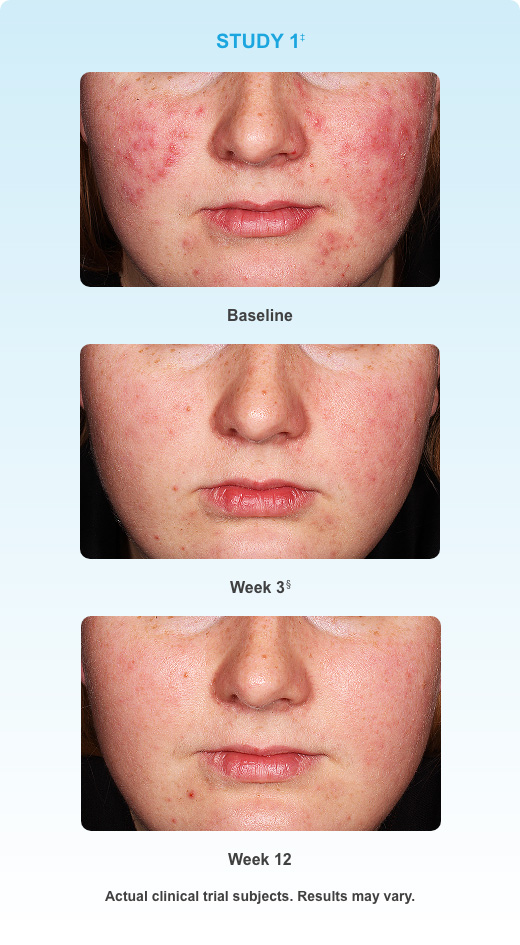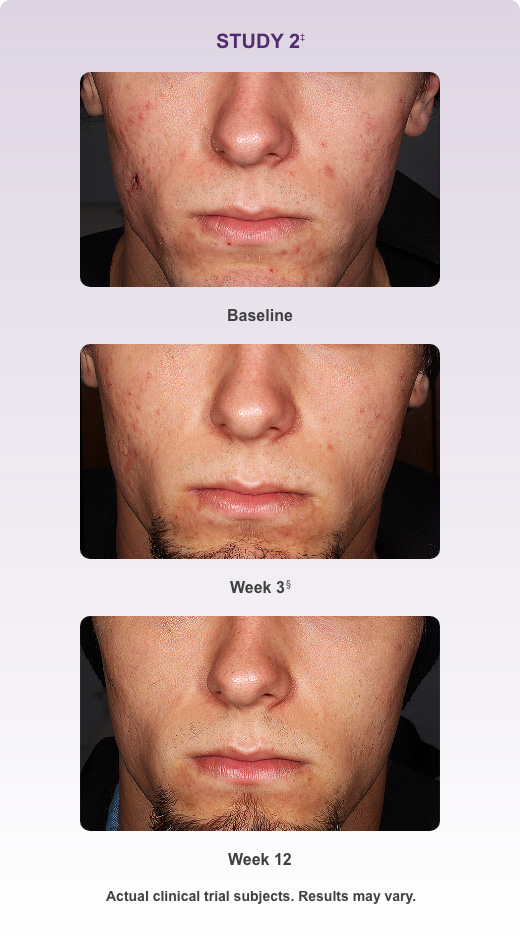Millions of Americans, struggle with acne — about 80% will deal with an outbreak between the ages of 11 and 30. Intense cases of acne can affect many facets of life, from self-esteem to gut bacteria composition. When facing acne, it’s common to turn to prescription medication to fight off bacteria. One new option on the market is Seysara (sarecycline). But, does Seysara actually work? Below are the facts, side effects, dosage, and how to use this tetracycline antibiotic — straight from a dermatologist.
What is Seysara (sarecycline)?
Seysara is an oral tetracycline antibiotic (like doxycycline) used to treat moderate to severe acne vulgaris. Seysara was approved in 2018 by the FDA for acne treatment in the United States.
What is Seysara used for? Seysara is used to reduce the number of pimples, lessen redness, and for treatment of inflammatory lesions from acne.
The chemical name of Seysara is sarecycline. At this point, there are no generic options on the market for Seysara.
How Seysara Treats Acne
Studies have shown that Seysara is a more targeted form of antibiotic treatment for acne than some other antibiotics for acne. Seysara is less likely to wipe out the good bacteria in your body or cause side effects while reducing acne-causing bacteria.
After 12 weeks of use, 22.6% of patients taking Seysara had clear or almost clear skin.
How can it have such positive results?
Seysara is an antibiotic that achieves results by killing C. acnes, a bacteria that lives your skin’s oil glands. When an excess of C. acnes is present, it can cause severe acne and breakouts. Seysara’s antibacterial agents are formulated to target and eliminate this bacteria.
Its antibiotic properties are helpful in the treatment of infections that can turn into large acne lesions.
Seysara also reduces inflammation, which helps to reduce other acne symptoms like redness.
Who can take Seysara?
Seysara was primarily designed for acne sufferers and is safe for most (but not all) patients ages 9 and up. In fact, clinical trials have followed patients up to 45.
We will cover more of the possible interactions and side effects below.
The Food and Drug Administration recommends that the following people should not take Seysara:
- Pregnant women or those still breastfeeding, as it may harm an unborn baby or be transmitted through breast milk
- Children under 9 years of age
- Those with an allergy to tetracycline-class antibiotics
- Those who have, or have a history of, esophageal issues
If you fall into one of these categories, don’t fear. You still have many other options for the treatment of acne. Seek out medical advice from a doctor or integrative dermatologist to find your best choice.
How to Take Seysara (Dosage & How Long)
Seysara is taken orally as a pill and should be consumed with a full glass of water. This reduces the amount of stomach irritation.
And let’s be honest: who couldn’t use a little more hydration?
There are three dosages of Seysara currently available, based on the patient’s age and weight:
- 60mg
- 100 mg
- 150 mg
Your dermatologist can help you find the correct dosage for you. Seysara is different than some other tetracycline antibiotics in that it can be taken with or without food.
How long does it take for Seysara to work? Seysara takes about 12 weeks to work best, according to most clinical trials. The drug’s website states that it is unclear if it’s safe to take Seysara for more than this 3-month period.
Modest initial results may be seen in as little as 3 weeks.
Results of Seysara for Acne (with Pictures)
The results of Seysara for acne can be evident in as little as 3 weeks, though you should always finish your course of antibiotics.
Here are some of the dramatic results patients taking Seysara have seen:
SOURCE: Seysara-HCP.com
SOURCE: Seysara-HCP.com
SOURCE: Journal of Drugs in Dermatology
Seysara Drug Interactions
While the use of Seysara can be an effective way to target acne-causing bacteria, this acne medication contains powerful properties. Mixing it with some other medications or supplements can cause adverse reactions.
Avoid these medications when taking Seysara:
- Oral retinoids (such as acitretin or isotretinoin)
- Strontium (often used for bone health and osteoporosis)
- Other strong antibiotics, such as penicillin
- The cholera vaccine (as it can hamper effectiveness)
- Antacids
For optimal absorption, wait 2-3 hours before taking Seysara after you take medications or supplements that contain:
- Bismuth subsalicylate
- Milk
- Aluminum
- Iron
- Calcium
- Magnesium
- Zinc
As with all prescription medications, talk with your doctor about any other medicines or supplements you are taking before starting Seysara.
Precautions & Side Effects of Seysara for Acne
Side effects may include:
- Nausea, vomiting, and diarrhea. These digestive problems are all possible side effects of Seysara, as with most antibiotics. Seysara increases the likelihood of clostridium difficile-associated diarrhea, which is characterized by watery stools.
- Sensitivity to light (photosensitivity). Tetracycline use can result in the skin sustaining sun damage and sunburn more easily. This can even occur from artificial light such as sunlamps and tanning beds. Use protective measures such as hats, sunscreen, and limited exposure to natural or artificial sunlight.
- Heartburn. This oral antibiotic can be harsh on the lining of the esophagus if taken incorrectly. Take your pill directly after a meal with a full glass of water to avoid irritating your throat. However, unlike many other antibiotic prescription drugs, you don’t need to take Seysara with a full meal.
- Central nervous system issues. Lightheadedness, dizziness, and vertigo may occur when using Seysara.
Rarely, more serious side effects may occur, such as:
- Permanent discoloration of the teeth. Children under 9 years old should not take Seysara as their permanent teeth are still growing in. Taking this medication during tooth development may tint them yellow-gray-brown. This discoloration is irreversible.
- Antibiotic resistance. When a full course of antibiotics is not finished, the body may develop antibiotic resistance (the development of drug-resistant bacteria within the gut). This is a serious condition that can limit the effectiveness of other antibacterial drugs. Be sure to finish the entire prescription in order to prevent this bacterial resistance.
- Slowed bone growth. For some infants and children, Seysara may slow bone growth. This is yet another reason why little ones should not be exposed to this medication. Thankfully, this may be reversible after discontinuing the medication.
Tetracycline antibiotics are associated with the rare side effect of intracranial hypertension (IH). This is typically seen only in the third trimester of pregnancy in women who are overweight or have experienced IH before.
If you experience headaches or vision problems while taking Seysara, stop taking it right away and call your prescribing physician.
Keep Seysara out of the reach of children and talk to your pediatrician if your child takes it by mistake.
Is Seysara right for you?
Seysara, though a new drug, seems to be a powerful option that targets the pesky bacteria causing acne.
If you are struggling with acne outbreaks, talk to your healthcare provider about Seysara. Though there are many categories of people that it doesn’t fit, as listed above, it can be a good resource for teens and adults struggling with acne.
Overall, Seysara has many points in its favor. Its narrow-scope action may help preserve your microbiome and its gastrointestinal side effects seem less common than other anti-acne antibiotics.
However, as a newer medication, a conversation with your dermatologist is advisable.
Sources
- Dunn, L. K., O’Neill, J. L., & Feldman, S. R. (2011). Acne in adolescents: quality of life, self-esteem, mood, and psychological disorders. Dermatology online journal, 17(1), 1-1. Abstract: https://pubmed.ncbi.nlm.nih.gov/21272492/
- Deng, Y., Wang, H., Zhou, J., Mou, Y., Wang, G., & Xiong, X. (2018). Patients with acne vulgaris have a distinct gut microbiota in comparison with healthy controls. Acta dermato-venereologica, 98(7-8), 783-790. Abstract: https://pubmed.ncbi.nlm.nih.gov/29756631/
- Leyden, J. J., Sniukiene, V., Berk, D. R., & Kaoukhov, A. (2018). Efficacy and Safety of Sarecycline, a Novel, Once-Daily, Narrow Spectrum Antibiotic for the Treatment of Moderate to Severe Facial Acne Vulgaris: Results of a Phase 2, Dose-Ranging Study. Journal of drugs in dermatology: JDD, 17(3), 333-338. Abstract: https://pubmed.ncbi.nlm.nih.gov/29537451/
- Moore, A., Green, L. J., Bruce, S., Sadick, N., Tschen, E., Werschler, P., … & Guenthner, S. (2018). Once-Daily Oral Sarecycline 1.5 mg/kg/day Is Effective for Moderate to Severe Acne Vulgaris: Results from Two Identically Designed, Phase 3, Randomized, Double-Blind Clinical Trials. Journal of drugs in dermatology: JDD, 17(9), 987-996. Abstract: https://pubmed.ncbi.nlm.nih.gov/30235387/
- Williams, H. C., Dellavalle, R. P., & Garner, S. (2012). Acne vulgaris. The Lancet, 379(9813), 361-372. Abstract: https://pubmed.ncbi.nlm.nih.gov/21880356/
- SEYSARA [package insert]. Exton, PA: Almirall, LLC, 2018. Full text: https://www.accessdata.fda.gov/drugsatfda_docs/label/2019/209521s001lbl.pdf
Starr, J. (2005). Clostridium difficile associated diarrhoea: diagnosis and treatment. Bmj, 331(7515), 498-501. Full text: https://www.ncbi.nlm.nih.gov/pmc/articles/PMC1199032/



